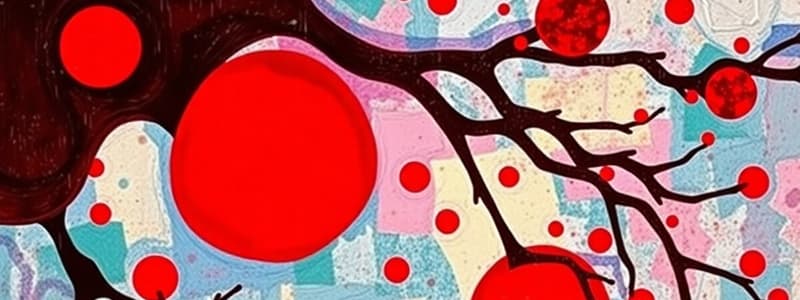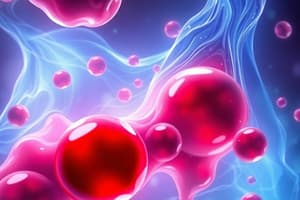Podcast
Questions and Answers
What component of blood makes up about 55% of its volume?
What component of blood makes up about 55% of its volume?
- Erythrocytes
- Leukocytes
- Blood Plasma (correct)
- Platelets
Which cells are primarily responsible for transporting oxygen and carbon dioxide in the blood?
Which cells are primarily responsible for transporting oxygen and carbon dioxide in the blood?
- Erythrocytes (correct)
- Leukocytes
- Platelets
- Reticulocytes
What is the process called that specifically focuses on the production of red blood cells?
What is the process called that specifically focuses on the production of red blood cells?
- Thrombopoiesis
- Leukopoiesis
- Erythropoiesis (correct)
- Hematopoiesis
What is the primary function of platelets in the blood?
What is the primary function of platelets in the blood?
What is the term for the pressure required to prevent the flow of water across a semipermeable membrane?
What is the term for the pressure required to prevent the flow of water across a semipermeable membrane?
Fetal hemoglobin has a higher affinity for which gas compared to adult hemoglobin?
Fetal hemoglobin has a higher affinity for which gas compared to adult hemoglobin?
What does hematocrit measure in the blood?
What does hematocrit measure in the blood?
What structural component of hemoglobin allows it to bind oxygen?
What structural component of hemoglobin allows it to bind oxygen?
What is deoxyhemoglobin?
What is deoxyhemoglobin?
Which type of blood cell is responsible for the body's defense against infections?
Which type of blood cell is responsible for the body's defense against infections?
What characterizes anemia?
What characterizes anemia?
What role do calcium ions play in blood coagulation?
What role do calcium ions play in blood coagulation?
Which blood type is considered the universal donor?
Which blood type is considered the universal donor?
What is the first stage in the process of blood clotting?
What is the first stage in the process of blood clotting?
What condition is indicated by leukopenia?
What condition is indicated by leukopenia?
In blood typing, what is an antibody?
In blood typing, what is an antibody?
What happens during hemolysis?
What happens during hemolysis?
Which of the following statements is correct about Rh negative blood?
Which of the following statements is correct about Rh negative blood?
Flashcards
What is blood plasma?
What is blood plasma?
The clear, liquid component of blood, primarily composed of water, electrolytes, proteins, hormones, and waste products. It serves as a medium for transporting vital substances throughout the body.
What are erythrocytes?
What are erythrocytes?
These are the red blood cells responsible for carrying oxygen to tissues and carbon dioxide back to the lungs. Their main component is hemoglobin, a protein that binds to oxygen.
What are leukocytes?
What are leukocytes?
These are white blood cells, key participants in the immune system, defending against infections. They come in various types, each with specialized roles in fighting off invading microorganisms.
What are platelets?
What are platelets?
Signup and view all the flashcards
What is hematopoiesis?
What is hematopoiesis?
Signup and view all the flashcards
What is erythropoiesis?
What is erythropoiesis?
Signup and view all the flashcards
What is hematocrit?
What is hematocrit?
Signup and view all the flashcards
What is hemoglobin?
What is hemoglobin?
Signup and view all the flashcards
Deoxyhemoglobin
Deoxyhemoglobin
Signup and view all the flashcards
Carbaminohemoglobin
Carbaminohemoglobin
Signup and view all the flashcards
Anemia
Anemia
Signup and view all the flashcards
Polycythemia
Polycythemia
Signup and view all the flashcards
Leukocytes
Leukocytes
Signup and view all the flashcards
Granulocytes
Granulocytes
Signup and view all the flashcards
Agranulocytes
Agranulocytes
Signup and view all the flashcards
Leukocytosis
Leukocytosis
Signup and view all the flashcards
Leukopenia
Leukopenia
Signup and view all the flashcards
Blood Clotting
Blood Clotting
Signup and view all the flashcards
Study Notes
Blood Composition and Function
-
Blood Plasma: Liquid component (55% of blood volume), containing water, electrolytes, proteins, hormones, and waste products. Transports nutrients, gases, hormones, and waste.
-
Erythrocytes (Red Blood Cells): Contain hemoglobin, crucial for transporting oxygen from lungs to tissues and carbon dioxide from tissues to lungs.
-
Leukocytes (White Blood Cells): Part of the immune system, fight infections through various responses. Categorized into granulocytes and agranulocytes.
-
Platelets (Thrombocytes): Cell fragments for blood clotting. Aggregate at injury sites, form temporary plugs, and release chemicals for coagulation cascade.
Blood Cell Formation and Characteristics
-
Hematopoiesis: Process of blood cell creation, primarily in bone marrow.
-
Erythropoiesis: Specific type of hematopoiesis focused on red blood cell production.
-
Reticulocyte: Immature red blood cell, released from bone marrow. Contains some organelles; matures into a functional erythrocyte.
-
Viscosity: Measure of a fluid's resistance to flow. Blood viscosity depends on red blood cell count and plasma proteins.
-
Osmolarity: Solute concentration in a solution, affecting water movement across cell membranes.
-
Osmotic Pressure: Pressure preventing water flow across a semipermeable membrane, influenced by solute concentration.
Hemoglobin Structure and Function
- Hemoglobin: Protein with four polypeptide chains and four heme groups. Each heme binds one oxygen molecule, enabling transport of up to four oxygen molecules. Carries carbon dioxide and maintains blood pH.
Hematocrit
- Hematocrit: Percentage of blood volume occupied by red blood cells; measures red blood cell concentration, indicating medical conditions.
Hemoglobin Types
-
Fetal Hemoglobin: Higher oxygen affinity than adult hemoglobin, crucial for oxygen transfer from mother to fetus.
-
Oxyhemoglobin: Oxygen-bound hemoglobin, typically in arterial blood.
-
Deoxyhemoglobin: Oxygen-unbound hemoglobin, usually in venous blood.
-
Carbaminohemoglobin: Carbon dioxide-bound hemoglobin, transporting CO2 from tissues to lungs.
Blood Disorders
-
Anemia: Low red blood cell or hemoglobin levels, reduces oxygen transport.
-
Polycythemia: Increased red blood cell count, leading to increased blood viscosity and potential complications.
Leukocyte Action and Types
-
Leukocyte Function: Body's defense against infections and foreign substances; identify, attack, and destroy pathogens; produce antibodies; coordinate immune responses.
-
Granulocytes: Include neutrophils (bacteria phagocytosis), eosinophils (parasite combat and allergies), and basophils (histamine release in allergies).
-
Agranulocytes: Include lymphocytes (specific immune responses), and monocytes (differentiate to macrophages for pathogen engulfment).
Leukocyte Abnormalities
-
Leukocytosis: Increased white blood cell count, often due to infection or inflammation.
-
Leukopenia: Decreased white blood cell count, increasing infection risk.
Blood Clotting
-
Blood Clotting Stages: Vascular spasm, platelet plug formation, coagulation (fibrin clot formation).
-
Vascular Spasm: Immediate constriction of blood vessels, reducing blood loss.
-
Platelet Plug Formation: Platelets adhere to injury site, release chemicals attracting more platelets, forming a temporary plug.
-
Coagulation: Cascade of reactions (involving clotting factors) for converting fibrinogen to fibrin, stabilizing the plug.
-
Calcium Ions in Clotting: Essential for many clotting factor activation steps.
Blood Types
-
Antigens: Substances triggering immune responses (on red blood cell surfaces).
-
Antibodies: Proteins produced by the immune system, binding to specific antigens.
-
Agglutination: Cell clumping (e.g., red blood cells) due to antibody-antigen binding.
-
ABO Blood Groups:
-
Type O: Universal donor; lacks A and B antigens.
-
Type A: A antigens; anti-B antibodies.
-
Type B: B antigens; anti-A antibodies.
-
Type AB: Universal recipient; both A and B antigens, no opposing antibodies.
-
Rh Blood Groups:
-
Rh Negative: Lacks Rh antigen; can develop antibodies if exposed to Rh-positive blood.
-
Rh Positive: Contains Rh antigen; can receive Rh-positive and Rh-negative blood.
-
Hemolysis: Destruction of red blood cells, releasing hemoglobin into bloodstream due to immune reactions or disease.
Studying That Suits You
Use AI to generate personalized quizzes and flashcards to suit your learning preferences.




